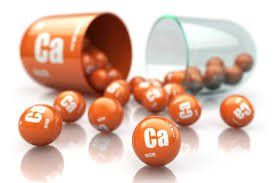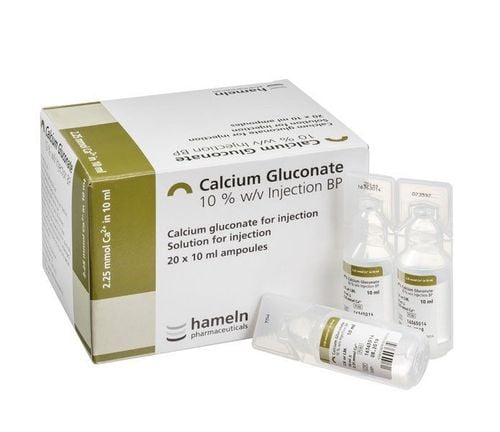This is an automatically translated article.
The article was professionally consulted by Specialist Doctor I Nguyen Hung - Department of Medical Examination & Internal Medicine - Vinmec Danang International Hospital. With over 36 years of experience in the profession, the doctor has experience in treating endocrine - diabetes and kidney diseases.
When there is a disorder of calcium metabolism, the human body will suddenly experience hypocalcemia or hypercalcemia. One of the causes of dyscalcemia is chronic kidney disease. In patients with chronic kidney disease, the arterial system often hardens, narrows, and reduces spasm, leading to ischemia of the target organs.
1. What is calcium metabolism disorder?
Calcium is one of the most important minerals for the body. Calcium is involved in muscle contraction, nerve conduction, blood clotting, and hormone release in the body.
The stability of calcium concentration depends on 3 factors: the amount of calcium taken into the body every day through eating and drinking calcium-containing foods; intestinal calcium absorption and renal calcium excretion.
The amount of calcium in the body is 1 - 2g, of which > 98% is in the bone organization, the rest is mainly in the extracellular space, 46% of calcium is bound to blood proteins, mainly albumin (80%). Total blood calcium concentration is 2.2 - 2.6 mmol/l (8.8-10.4 mg%), ionized calcium concentration is 1.3 mmol/l (4.8mg%). Extracellular calcium concentration is 10,000 times higher than intracellular calcium. When there is a disorder of calcium metabolism, the human body will suddenly experience hypocalcemia or hypercalcemia:

Symptoms of hypocalcaemia: Hypocalcemia when ionized calcium concentration < 0.9 mmol/l or total calcium < 1.9 mmol/l; Visual disturbances: Illusion, diplopia, arousal, fear; Spasticity of the fingers, the delivery hand, Chvostek's sign (+), Trousseau's sign (+), when these signs appear, signal the beginning of tetany; Seizures appear suddenly and may not have any warning signs, in many cases, seizures are caused by biting the tongue. The convulsions come on rapidly, after complete awakening; Smooth muscle spasms causing abdominal pain, nausea; Chronic hypocalcemia leads to osteoporosis, osteomalacia, spontaneous fractures. Symptoms of hypercalcemia: Hypercalcemia when the total blood calcium concentration exceeds 2.5 mmol/l or ionized calcium exceeds 1.55 mmol/l; Polyuria, urine volume exceeding 2000 ml/day; Loss of appetite, constipation, nausea; Abdominal pain, bloating due to increased gastric acid secretion, increased pepsin secretion; Fatigue, weakness; Kidney stones , calcium infection of the kidney and other organs.
2. Disorders of calcium metabolism in patients with chronic kidney disease
2.1. Overview of chronic kidney disease Chronic kidney disease is defined as:
At least one abnormality in renal structure or function occurs and persists for 3 months or more from any cause; Chronic kidney disease was also defined when the glomerular filtration rate was < 60 ml/min/1.73 m2 of skin for 3 months or more even without structural damage to the kidney; Several different causes of chronic kidney disease include primary kidney disease and secondary kidney disease. The progression of chronic kidney disease is an irreversible process, sequentially in stages, progressing quickly or slowly depending on many intrinsic factors of the patient, the cause of the chronic kidney disease, and the effectiveness of measures. treatment.
According to the American Heart Association, chronic kidney disease is considered a risk factor for cardiovascular disease. Besides the traditional cardiovascular risk factors, calcium and phosphorus disorders, secondary hyperparathyroidism are among the non-traditional cardiovascular risk factors that have increased the rate of coronary artery disease as well as death. cardiovascular mortality in patients with chronic kidney disease.

2.2. Chronic kidney disease patients with calcium metabolism disorders One of the causes of disorders of blood calcium metabolism is chronic kidney disease such as: chronic renal failure, renal tubular acidosis type I, renal tubular acidosis type II, syndrome Fanconi's syndrome, Nephrotic syndrome (loss of protein bound calcium), secondary hyperparathyroidism, aluminum toxicity during hemodialysis,...
In adults, total body calcium is about 1300g, of which 99% is involved in bone structure, 1% in intracellular fluid and 0.1% in extracellular fluid. Calcium is absorbed through the intestinal brush and actively transported into the body. Normally calcium is absorbed about 200 mg per day, the kidneys excrete the amount of calcium each day in balance with the amount absorbed. In addition, the kidneys also produce calcitriol from vitamin D, which aids in the absorption of calcium from the intestines. Both processes are stimulated by PTH. The concentration of free calcium affects neuromuscular activity and other cellular functions and is controlled by hormones, especially PTH. In serum, calcium exists in three forms: free form, bound to plasma proteins and very small form, soluble complexes. Total calcium concentration is 2.2 – 2.5 mmol/l and ionized calcium is 1.0 – 1.3 mmol/l. Plasma albumin concentration is an important factor affecting calcium ion concentration.
Disorders of blood calcium metabolism are characteristic changes in patients with chronic kidney disease. The relationship between the three indexes above is in the forward and reverse direction, in which increased phosphorus concentration leads to decreased calcium and secondary hyperparathyroidism, increased PTH. Disturbances in calcium levels in patients with chronic kidney disease usually appear early when the glomerular filtration rate is less than 60-80 ml/min/1.73m2 of skin.
Blood calcium concentration is a factor that regulates the synthesis and secretion of PTH. Patients with chronic kidney disease when glomerular filtration rate < 60 ml/min/1.73 m2 of skin often have decreased serum calcium concentration. Blood calcium concentration is positively correlated with glomerular filtration rate. Ramos A.M. et al (2008) studied 125 patients (glomerular filtration rate < 60 ml/min), found that blood calcium levels in patients with stage 3, 4 and 5 chronic kidney disease were 9.5mg, 9.0mg, respectively. and 8.9mg/100ml. When the concentration of extracellular calcium decreases, the feedback mechanism will stimulate the parathyroid gland to increase the synthesis of PTH.
In patients with chronic kidney disease, because the normal function of PTH cannot be maintained to regulate calcium levels, calcium will be deposited on the walls of the arteries, leading to calcification of the artery walls, making the arteries harden. , reduction or loss of elasticity, narrowing of the aperture. Therefore, in patients with chronic kidney disease, the arterial system often hardens, narrows, and reduces spasm, leading to lack of blood to nourish the target organ.
Please dial HOTLINE for more information or register for an appointment HERE. Download MyVinmec app to make appointments faster and to manage your bookings easily.














